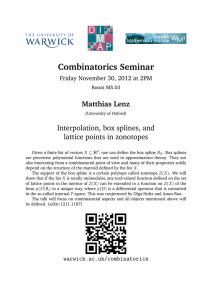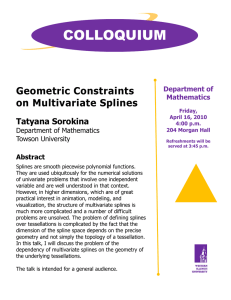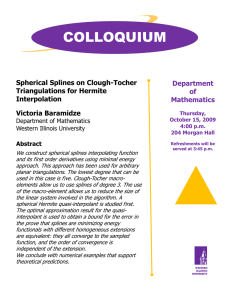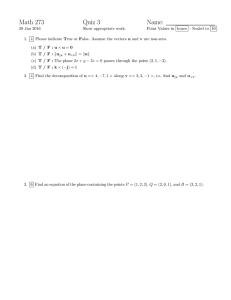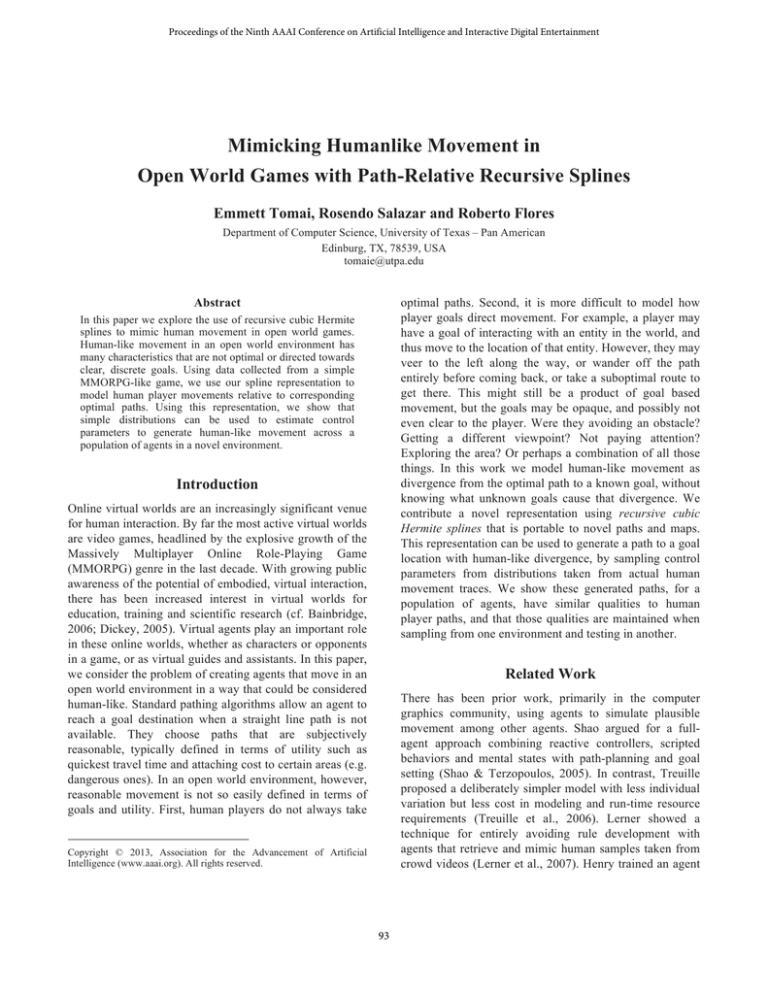
Proceedings of the Ninth AAAI Conference on Artificial Intelligence and Interactive Digital Entertainment
Mimicking Humanlike Movement in
Open World Games with Path-Relative Recursive Splines
Emmett Tomai, Rosendo Salazar and Roberto Flores
Department of Computer Science, University of Texas – Pan American
Edinburg, TX, 78539, USA
tomaie@utpa.edu
Abstract
optimal paths. Second, it is more difficult to model how
player goals direct movement. For example, a player may
have a goal of interacting with an entity in the world, and
thus move to the location of that entity. However, they may
veer to the left along the way, or wander off the path
entirely before coming back, or take a suboptimal route to
get there. This might still be a product of goal based
movement, but the goals may be opaque, and possibly not
even clear to the player. Were they avoiding an obstacle?
Getting a different viewpoint? Not paying attention?
Exploring the area? Or perhaps a combination of all those
things. In this work we model human-like movement as
divergence from the optimal path to a known goal, without
knowing what unknown goals cause that divergence. We
contribute a novel representation using recursive cubic
Hermite splines that is portable to novel paths and maps.
This representation can be used to generate a path to a goal
location with human-like divergence, by sampling control
parameters from distributions taken from actual human
movement traces. We show these generated paths, for a
population of agents, have similar qualities to human
player paths, and that those qualities are maintained when
sampling from one environment and testing in another.
In this paper we explore the use of recursive cubic Hermite
splines to mimic human movement in open world games.
Human-like movement in an open world environment has
many characteristics that are not optimal or directed towards
clear, discrete goals. Using data collected from a simple
MMORPG-like game, we use our spline representation to
model human player movements relative to corresponding
optimal paths. Using this representation, we show that
simple distributions can be used to estimate control
parameters to generate human-like movement across a
population of agents in a novel environment.
Introduction
Online virtual worlds are an increasingly significant venue
for human interaction. By far the most active virtual worlds
are video games, headlined by the explosive growth of the
Massively Multiplayer Online Role-Playing Game
(MMORPG) genre in the last decade. With growing public
awareness of the potential of embodied, virtual interaction,
there has been increased interest in virtual worlds for
education, training and scientific research (cf. Bainbridge,
2006; Dickey, 2005). Virtual agents play an important role
in these online worlds, whether as characters or opponents
in a game, or as virtual guides and assistants. In this paper,
we consider the problem of creating agents that move in an
open world environment in a way that could be considered
human-like. Standard pathing algorithms allow an agent to
reach a goal destination when a straight line path is not
available. They choose paths that are subjectively
reasonable, typically defined in terms of utility such as
quickest travel time and attaching cost to certain areas (e.g.
dangerous ones). In an open world environment, however,
reasonable movement is not so easily defined in terms of
goals and utility. First, human players do not always take
Related Work
There has been prior work, primarily in the computer
graphics community, using agents to simulate plausible
movement among other agents. Shao argued for a fullagent approach combining reactive controllers, scripted
behaviors and mental states with path-planning and goal
setting (Shao & Terzopoulos, 2005). In contrast, Treuille
proposed a deliberately simpler model with less individual
variation but less cost in modeling and run-time resource
requirements (Treuille et al., 2006). Lerner showed a
technique for entirely avoiding rule development with
agents that retrieve and mimic human samples taken from
crowd videos (Lerner et al., 2007). Henry trained an agent
Copyright © 2013, Association for the Advancement of Artificial
Intelligence (www.aaai.org). All rights reserved.
93
controller using inverse reinforcement learning to navigate
through crowded environments, making the distinction
between shortest and human-like paths (Henry et al.,
2010). Both the environment and the training data were
generated by simulation. These approaches focus
particularly on maintaining plausible behavior in crowded
environments, as human pedestrians do. Players in an open
virtual world do not move with that deliberative pace and
flow, so the techniques involved may not transfer well. It is
also worth noting that the majority of evaluations are
qualitative visual examples, underlining the difficulty of
quantitative analysis.
A number of evolutionary approaches have been
evaluated for developing more human-like agent
controllers. Graham used a genetic algorithm to evolve an
artificial neural network that implements dynamic obstacle
avoidance while following a direct path (Graham, 2005).
Togelius evaluated several co-evolution strategies for
creating car racing controllers with the aim of deploying a
diverse population of human-like AI opponents in a car
racing game (Togelius et al., 2007). These approaches are
evaluated according to whether they effectively traverse
space while avoiding obstacles and hitting checkpoints,
making them human-like from a functional point of view.
In the domain of video games, particular interest has
been shown in developing human-like movement for
agents in the first-person shooter (FPS) genre. Geisler
notes the high predictability and manual labor involved in
traditional AI scripting of game agent opponents (bots) as
motivation for automatic learning of human-like behavior
(Geisler, 2004). These behaviors included low-level
movement primitives such as changing direction, changing
speed and jumping, as well as basic game actions such as
aiming and firing a weapon at opponents. Gamez showed
that a global workspace architecture combining
independent, hand-tuned neural networks can deliver
human-like bot control (Gamez et al., 2013). Thurau used
self-organizing maps and artificial neural networks to learn
those primitive actions based on position and relative
enemy positions (Thurau et al., 2003). Geisler evaluated
both naïve Bayes and neural network approaches to this
problem with promising results (Geisler, 2004). Schrum
created a FPS bot architecture that learns combat behavior
using neuroevolution (Schrum et al., 2012) and won the 2K
Games’ 2012 BotPrize while being judged as human more
than 50% of the time (Karpov et al., 2012). These and
numerous other results (cf. Galway et al., 2008) have
demonstrated that machine learning and evolutionary
computation are well suited to optimizing behavior control
in the fps domain, where the problem has a reactive nature
(e.g. positioning relative to other agents, strategic
responses), a small number of output dimensions (e.g.
movement and facing) and works at a single level of
abstraction (Bakkes et al., 2012). However, the larger
question of complex behavior requires working at multiple
levels of abstraction (Bakkes et al., 2012). Ultimately, that
is the goal for open world behavior as well.
Modeling Player Movement
In MMORPGs, players control avatar characters in a
physically simulated virtual world. In contrast to more
reactive and/or linear environments in other genres, players
roam freely in the world, picking up tasks and completing
them at their own discretion. At a high level, there is goaldirected travel between the regions where tasks are
acquired, completed and turned in for credit. To collect
player behavior data, we created a lightweight, research
focused MMORPG. We gathered data from 37 human
players playing together in a laboratory setting. The game
collects a wide range of data for each player, including
movement, avatar actions, UI actions and visibility of other
entities. For the purposes of this study, we isolated traces
of player movement between regions. For example, Figure
1 shows two such traces as yellow lines. They are
identified from the collected data by interaction events
(interacting with in-game characters, enemies or other
entities) at the beginning and end. Most of the movement
within regions consists of combat or other highly directed
behavior, so was set aside for other study. The data set
consists of 162 movement traces grouped into 8 region-toregion groups.
Figure 1: Navigation mesh with human traces (yellow) and
corresponding optimal paths (white).
94
Figures 2a and 2b: A human trace (yellow) projected into pathrelative space u,offset based on the normals (blue) of the
corresponding path (white).
Figure 3: Human trace (solid, green) fit by a
recursive Hermite spline (first-order: dotted, red;
second-order: dotted, blue; third-order: dashed,
purple).
point becomes a tuple (u,offset), where u is the distance
along the path and offset is the distance along the normal
from the path to the point. Those normals are computed at
each funnel point (shown in blue in Figure 2a) as the
average of the perpendicular normals of each adjacent path
edge, and linearly interpolated between the funnel points.
Figure 2b shows the projection of the human movement
trace from Figure 2a into path space (u,offset). The large
blue dots along the x-axis indicate the positions of the
funnel points in u. In these experiments, the sampling rate
for the project is equal to the sampling rate used in the data
collection, but it does not have to be.
The long human movement trace on the left side of
Figure 1 shows multiple yellow circles along the trace that
are treated as intermediate target locations. In plain terms,
any time the player is not moving in a way consistent with
the path to the end goal (the end of the trace), they must be
moving towards some other target location within the
trace. These intermediate target locations are assumed to
be motivated by some unknown player goal (e.g. went over
to look at a flower along the way). The human movement
trace is automatically segmented by those locations such
that the projection of each trace segment is monotonic
along the generated path from the beginning to the end of
that segment. The segmentation is done by working
backwards along the trace, adding points to a segment until
it results in a non-monotonic projection, which identifies
an intermediate target location at that point. There are two
intermediate target locations in the example trace. This
work only uses intermediate target locations, and does not
extend to predicting their occurrences.
Path Modeling
The first step in our approach is to identify a path to a goal
location. Many of the systems discussed in the related
work section train and test in the same environment (game
map), because they learn movement relative to the
topology of that map. To allow our model to apply to novel
environments, we instead model movement relative to
paths that can be automatically generated using fast,
standard algorithms. Variations on A* search have long
been the standard way to compute paths in research and the
games industry. In some games, this can be implemented
on a grid in a very straightforward way. However, in
sophisticated virtual worlds, it is common to use a
navigation mesh. This is a mesh of edge-connected
polygons (typically triangles and/or quadrilaterals) that is
manually overlaid by a designer on the game world. Figure
1 shows part of the navigation mesh in our lightweight
MMORPG. Because the navigation mesh is still a graph,
graph search can be used to find paths. However, once a
sequence of mesh nodes is identified as a path, specific
waypoints must be chosen within those nodes. Using
centroids, corners or edge midpoints creates very
unnatural, jagged paths. A common solution is the funnel
or string-pulling algorithm, which finds the optimal
waypoints through a sequence of mesh nodes (Lee &
Preparata, 1984). Figure 1 shows two human movement
traces in yellow. First consider the shorter trace on the
right. The corresponding straight white lines show the path
generated using the navigation mesh and funnel algorithm
between the start and end points (yellow circles) of the
human trace. The corners of the white paths are funnel
points.
To represent the human movement in a path-relative
way, we project the points in the trace onto the path. Each
Recursive Splines
To facilitate learning and mimicking these movement
traces, we present a compact representation based on
95
recursive cubic Hermite splines. These splines (and subsets
such as Catmull-Rom splines) are commonly used to
represent curving paths in computer animation. A Hermite
spline defines a curve as a linear interpolation between two
points based on a tangent leaving the first point and a
tangent arriving at the second point. This is a natural fit for
an agent leaving the path and curving back to it, as seen in
the example traces. In order to fit the human movement
trace, we represent the coarse, low-frequency component
of the trace using what we will call the first-order recursive
splines. The first-order recursive splines for the example
trace shown in Figure 2a and 2b are shown as a red dotted
line in Figure 3. Each spline leaves the path and returns to
it, so for the single crossing of the human movement trace
in this example, there are 2 first-order recursive splines.
Each spline is defined by its start and end points in u (the
start and end of the path and the single crossing point), and
the tangents at those points. The tangents are estimated by
taking the derivative of the cubic B-spline interpolation at
those points using the scipy1 implementation of Dierckx's
spline fitting algorithms (Dierckx, 1993). Those estimated
tangents are then refined using a recursively finer grained
grid search over the angle and magnitude to minimize the
mean square distance (MSD) between the spline curve and
the human trace points.
Once the first-order splines have been created, the
human trace in (u,offset) is projected against those splines
to create a new projection of the remaining error. That
projection is used to recursively create second-order
recursive splines that make higher-frequency crosses of the
parent first-order splines. This process continues until a
minimum threshold MSD is reached, or a specified depth
limit is reached. The dotted blue line in Figure 3 shows the
second-order spline fit (with the second-order splines
added to the first-order), and the dashed purple line in
Figure 3 shows the third-order spline fit. Table 1 shows the
mean square distances at different depths of recursion,
averaged across all the human movement traces being used
in this work. As shown, the gains in fit fall off sharply after
third-order splines, so that limit is used.
By modeling the human movement traces as recursive
splines relative to the path in (u,offset), we have created a
small number of parameters that control the shape of the
movement in a portable way. Given a set of training traces,
a model can be trained to sample from the distribution of
appropriate values for each parameter.
Path Generation
To generate a human-like path to a goal, an agent first must
compute the optimal path as described in the prior section.
It then generates a sequence of recursive splines (to a given
depth) for human-like movement along that path by using a
model to sample controlling parameter values. For each
path segment (separated by the funnel points), the number
of crossing points is sampled from the model. These values
are modified according to two constraints. 1) If a segment
runs along an impassable edge of the navigation mesh,
there can be no crossing points in that segment. 2) If a
crossing causes the path to end up on an impassable side in
a later segment, another crossing is added. The locations
of the crossings within each segment are also sampled
from the model. Once the set of crossing points is
determined, it defines the beginnings and ends of the firstorder splines. The starting and ending tangent parameters
are similarly sampled from the model. It then recursively
generates higher-order splines in the same manner, to the
specified depth. The only difference is that the higherorder splines do not take the path segments into account,
but predict crossing points along their parent spline
instead. Once the full recursive splines have been created,
they can be followed by evaluating it and its children along
u (using the agent’s movement speed) and summing the
resulting offsets, then projecting that (u,offset) from the
path back into world space. The cost of the algorithm is
polynomial in the number of crossings generated at each
level, which in this data set is predominantly in the range
of 1-3 at all levels. Even this cost could be amortized over
the entire movement by only generating the recursive
spline up to the next crossing at the deepest level.
Figure 4 shows human-like paths (blue) generated by
this algorithm using the same target locations as the human
movement traces in the running example. Figure 5 shows a
complete set of region-to-region human movement traces
(yellow) and a corresponding set of generated paths
(purple).
Table 1: Average mean square distances between the
recursive splines and the human traces they are fitting.
depth
0
1
2
3
4
5
1
MSD
STDDEV
83.77601
14.34542
2.851349
0.77223
0.460432
0.412963
101.13
18.37096
3.767416
0.776236
0.44196
0.430128
Parameter Sampling
Path generation as described above requires a model of the
controlling parameter distributions. The crossing point
parameters are the number of times a path segment or
spline is crossed by a higher-order spline, and the relative
locations of those points as percentages of the extent of the
http://www.scipy.org
96
segment or spline in u. The spline tangent parameters are
the (u,offset) components of the tangent, normalized by the
path extent in u covered by the spline.
variable X and its cumulative distribution function (CDF)
F, a random number x in X can be generated by generating
a random number y from a uniform distribution such that
F(x) = y (cf. Devroye 1986). This is simple to implement
for finite, discrete data, as the CDF is simply the
integration of the probability density function of X, and the
inverse transform can be done as a lookup table, essentially
the same as common game industry hit tables.
Evaluation
Evaluating behavior that is not intended to be optimal or
narrowly task focused is quite difficult. The problem is
further complicated because the goal is not to mimic a
particular human movement trace, but to generate a
population of agents have the same qualities in their
movement as the human players. Various metrics have
been tested (cf. Gamez et al., 2013), but their utility
remains an open question. Here we consider distributional
similarity: for a given metric, to what extent does the
distribution generated by an agent population match the
distribution generated by a human player population? As in
many curve matching approaches, the similarity is
computed as the mean square distance (MSD) between the
values in the distributions, evaluated in discrete bins over
the union of their ranges. We experimented with using
cubic smoothing over the distributions in the MSD
calculation, but found no notable difference in the results.
In the first experiment, the normal and training
distributions are drawn from all the region-to-region traces
in the data set. Then, for all the traces in that set, the
algorithm generates a population of paths, over the same
target locations, for each of the two distribution models.
The purpose of this self-test experiment is to calibrate the
similarity metrics for an agent population vs. a human
population.
In the second experiment, the region-to-region traces are
divided into two sets. Each set contains half of the
start/end region pairings, selected randomly. The normal
and training distributions are taken from one set, then used
to generate a population of paths according to the traces in
the other set. The purpose of this experiment is to verify
that this approach can use data from one set of paths with a
certain topology to generate paths for novel locations in a
different topology. The generated movement should show
the same distribution similarity to human traces as the selftest. In both experiments we hypothesize that the humangenerated training distribution should be more effective at
parameter estimation than the normal distribution.
Four evaluation metrics are used. The number of path
crossings is an indicator of broad (low-frequency) backand-forth movement off the optimal path. The number of
high-frequency crossings is counted from the higher-order
Figure 4: Generated paths (blue) over the same target
locations as the human traces (yellow).
Figure 5: Human traces (yellow) and generated paths
(purple) over the same target locations.
In this work, we investigate two distributions for
parameter estimation. These are taken globally over the set
of training traces. The first, intended to be a baseline, is the
Gaussian normal distribution of the parameter given the
mean and standard deviation of the training data (hereafter
normal). These parameters do not follow a normal
distribution in the training data, but it is the obvious first
choice for introducing randomness into agent movement.
The second, intended to verify the feasibility of this
approach and give insight into evaluation metrics, is
inverse transform sampling from the training distribution
(hereafter training). Given a parameter as a random
97
splines crossing the first-order splines, an indicator of how
smooth or bumpy the path is. The path area is the mean
square distance between the generated path and the optimal
path, an indicator of how far off the optimal path the
generated path moves. Finally, the path slack is the length
of the generated path divided by the length of the optimal
path, an indicator of how direct the movement is. Each
metric is calculated for the human traces, the paths
generated with the normal distribution and the paths
generated with the training distribution. The distribution of
each metric for the generated paths is compared to the
distribution of that metric for the human traces, and the
MSD is calculated. Smaller MSD values indicate more
similarity to the human traces, as a population. Each
experiment was run 5 times and the mean and standard
deviation reported.
Conclusion
We have presented an approach to modeling and
generating human-like movements in an open-world virtual
environment such as found in the MMORPG genre. We
have shown how recursive splines can be used for pathrelative modeling that translates easily to different
locations and environments based on industry-standard
path-finding techniques. We have also provided empirical
evidence that simple distribution sampling of parameters
from human traces can generate these splines on a novel
path, in a way that satisfies some measures of humanlikeness to the movement. Finally, we have presented a set
of possible quantitative metrics for such measurement and
demonstrated their use with a measure of distribution
similarity.
While this technique generates what appear to be quite
reasonable and useful movements, the use of global normal
and training distributions is a substantial simplification.
We have done preliminary tests with Bayesian support
vector regression and Gaussian processes for parameter
estimation, based on features such as the width of the
navmesh funnel, the sharpness of path segment corners and
the presence of obstacles. However, given the difficulty of
evaluation, we felt that the strong performance of global
distribution sampling warranted further investigation. As
the results show, there is at least a reasonable level of
fidelity that can be gained in this very general,
straightforward way. We hope that this study will provide a
clearer baseline to expand the work with machine learning.
The most challenging element continues to be finding
ways to quantitatively evaluate a population of agents'
behaviors for human likeness. Clear future work includes
having humans make qualitative judgments, but we must
continue to establish objective measures and hypotheses
about them, or a lot of time may be wasted on expensive
and undirected human subject evaluations.
Because this work is applicable to real-time simulation,
and shared virtual worlds in particular, the practical
efficiency of the algorithm is another important question. It
is worth noting that hit tables are well understood, and the
spline evaluations are common in graphics applications
and conducive to matrix-based implementation, creating
possible synergy with consumer hardware acceleration.
Results
The results of the experiments are shown in Table 2. In
path crossings and path slack, the training distribution
outperforms the normal distribution as predicted in both
experiments (best values in bold). However, in path area
the values show no difference relative to their standard
deviations, and in high-frequency crossings the normal
distribution outperforms the training distribution even in
the self-test. It does not appear from these results that the
training distribution has a notable advantage over the
normal distribution. Comparing the two experiments, the
distributions perform in a similar pattern and range in
experiment 2 as experiment 1. This provides some
evidence that even these distributions, with no
sophisticated correlations to environmental variables, have
some portability. However the magnitude of the difference
in distribution similarity remains un-calibrated except by
visual, qualitative assessment of the generated paths.
Table 2: Results for self-test (Exp1) and region-to-region
(Exp2) experiments for normal and training distributions.
HF crossings = high-frequency crossings.
Metric
Path
crossings
HF
crossings
Path area
Path slack
Dist
normal
training
normal
training
normal
training
normal
training
Exp. 1
mean
0.316
0.115
0.015
0.031
0.001
0.001
12.31
10.97
std
0.055
0.059
0.001
0.005
0.001
0.001
2.543
2.031
Exp. 2
mean
0.532
0.305
0.034
0.072
0.007
0.006
29.32
27.59
std
0.285
0.280
0.016
0.019
0.005
0.003
4.78
4.60
Acknowledgements
This material is based upon work supported in part by the
U.S. Army Research Laboratory and the U.S. Army
Research Office under grant number W911NF-11-1-0150.
98
Tomai, E., Salazar, R. and Flores, R. (2013). Simulating
Aggregate Player Behavior with Learning Behavior Trees. In
Proceedings of the 22nd Annual Conference on Behavior
Representation in Modeling & Simulation.
Treuille, A., Cooper, S. and Popović, Z. (2006). Continuum
Crowds. ACM Trans. Graph, vol 25, pg 1160-1168.
References
Bainbridge, W.S. (2007). The Scientific Research Potential of
Virtual Worlds. Science. Vol. 317 no. 5837 pp. 472-476.
Bakkes, S., Spronck, P., and van Lankveld, G. (2012). Player
Behavioral Modeling for Video Games. Entertainment
Computing, Vol. 3, Nr. 3, pp. 71–79.
Devroye, L. (1986). Non-Uniform Random Variate Generation.
New York: Springer-Verlag.
Dickey, M.D. (2005). Three-dimensional virtual worlds and
distance learning: two case studies of Active Worlds as a medium
for distance education. British Journal of Educational
Technology. Volume 36, Issue 3, pages 439–451.
Dierckx, P. (1995). Curve and surface fitting with splines.
Monographs on Numerical Analysis, Oxford University Press.
Gamez, D., Fountas, Z., Fidjeland, A.K. (2013). A neurally
controlled computer game avatar with humanlike behavior. IEEE
Transactions on Computational Intelligence in Games, vol 5, no
1, March 2013.
Galway, L., Charles, D. and Black, M. (2008). Machine learning
in digital games: a survey. Artificial Intelligence Review. Volume
29, Number 2, 123-161.
Geisler, B. (2004). Integrated machine learning for behavior
modeling in video games. In: Fu D, Henke S, Orkin J (eds)
Challenges in game artificial intelligence: papers from the 2004
AAAI workshop. AAAI Press, Menlo Park, pp 54–62.
Graham, R. (2005). Realistic Agent Movement in Dynamic Game
Environments. DiGRA 2005: Changing Views: Worlds in Play,
2005.
Henry, P., Vollmer, C., Ferris, B. and Fox, D. (2010). Learning to
navigate through crowded environments. In Proceedings ot the
2010 IEEE International Conference on Robotics and
Automation, Anchorage Convention District, May 3-8, 2010,
Anchorage, Alaska, USA
Karpov, I.V., Schrum, J., Miikkulainen, R. (2012). Believable Bot
Navigation via Playback of Human Traces. In Philip F. Hingston,
editors, Believable Bots, 151--170, 2012. Springer Berlin
Heidelberg.
Lee, D.T. and Preparata, F.P. (1984). Euclidean shortest paths in
the presence of rectilinear barriers. Networks, 14:393--410.
Lerner, A., Chrysanthou, Y. and Lischinski, D. (2007). Crowds
by Example. EUROGRAPHICS, Vol 26, no 3.
Schrum, J., Karpov, I.V. and Miikkulain, R. (2012). Humanlike
Combat Behavior via Multiobjective Neuroevolution. In Philip F.
Hingston, editors, Believable Bots, 119--150, 2012. Springer
Berlin Heidelberg.
Shao, W., and Terzopoulos, D. (2005). Autonomous pedestrians.
In
SCA
’05:
Proceedings
of
the
2005
ACM
SIGGRAPH/Eurographics symposium on Computer animation,
ACM Press, New York, NY, USA, 19–28.
Thurau, C., Bauckhage, C., Sagerer, G. (2003). Combining selforganizing maps and multilayer perceptrons to learn bot-behavior
for a commercial game. In Mehdi Q, Gough N, Natkin S (eds)
Proceedings of the 4th international conference on intelligent
games and simulation. Eurosis, pp 119–123.
Togelius, J., Burrow, P. and Lucas, S.M. (2007). Multipopulation competitive co-evolution of car racing controllers.
Proceedings of the IEEE Congress on Evolutionary Computation
(CEC), 4043-4050.
99

